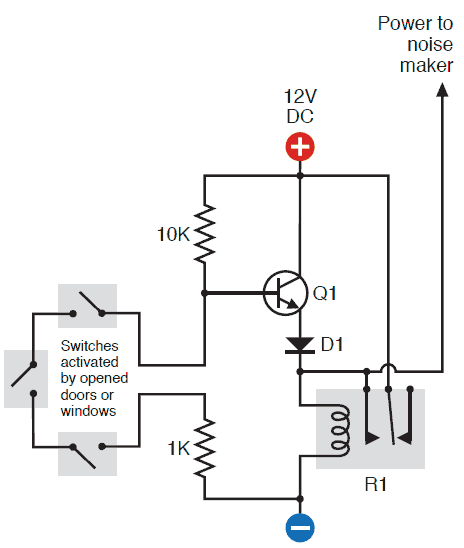
Dummy Alarm Project

This Dummy Alarm project causes an LED to flash briefly every 5 seconds, simulating the indicator light of a real alarm. The circuit is designed to consume minimal current to extend battery life, allowing it to remain powered continuously. An on/off switch is not included but could be added if desired. The circuit employs a 7555 timer IC, a low-power variant of the standard 555 timer. A super-bright red LED is utilized, providing a bright flash while maintaining low current consumption. The LED remains off for the majority of the time, resulting in an average total current draw of less than 0.2 mA. With this low current, a set of three alkaline AA cells can last several months, potentially up to a year. The circuit can also function with a standard 555 timer IC (like the popular NE555), although this would increase the average current to approximately 2 mA, significantly reducing battery life. The circuit can accommodate a higher supply voltage (up to 15V), but the 1k resistor for the LED should be adjusted to maintain low current, ideally around 3 mA. For instance, when using a 9V PP3 battery, the 1k resistor should be replaced with a 3.3k resistor. It is important to note that AA batteries will generally outlast a 9V PP3 battery.
The Dummy Alarm circuit operates using a 7555 timer IC configured in astable mode. In this configuration, the timer generates a square wave output that controls the blinking of the LED. The timing components, typically a resistor and a capacitor, determine the frequency of the output signal. For a flash every 5 seconds, appropriate resistor and capacitor values must be selected. The LED is connected in series with a current-limiting resistor to ensure it operates within safe current limits.
When designing the circuit, it is crucial to select a super-bright red LED to maximize visibility while minimizing power consumption. The choice of a 7555 timer over a standard 555 timer is significant, as it allows for extended operation on battery power due to its lower current requirements.
The circuit can be powered by a variety of battery types, including alkaline AA cells or a PP3 9V battery, with the understanding that the resistor values must be adjusted accordingly to maintain the desired LED current. The resistor value can be calculated using Ohm's law, taking into account the supply voltage and the forward voltage drop of the LED.
In summary, the Dummy Alarm project is an efficient circuit that simulates an alarm indicator light with minimal power consumption, making it suitable for long-term use. Adjustments to the resistor values and choice of timer IC can further optimize performance based on available power sources.This Dummy Alarm project makes an LED flash briefly once every 5 seconds to imitate the indicator light of a real alarm. The circuit is designed to use very little current to prolong battery life so that it can be left on permanently.
An on/off switch is not included, but could be added if you wish. The 7555 timer IC used is a low power version of the standard 555 timer. A `superbright` red LED is used because this provides a bright flash with a low current. The LED is off for most of the time so the average total current for the circuit is less than 0. 2mA. With this very low current a set of 3 alkaline AA cells should last for several months, maybe as long as a year. The circuit will work with a standard 555 timer IC (such as the popular NE555) but this will increase the average current to about 2mA and the battery life will be much shorter.
You can use a greater supply voltage (15V maximum) for this circuit but the 1k resistor for the LED should be increased to keep the LED current low at about 3mA. For example to use a 9V PP3 battery change the 1k resistor to 3k3. Note that AA cells will last longer than a 9V PP3 battery. 🔗 External reference
The Dummy Alarm circuit operates using a 7555 timer IC configured in astable mode. In this configuration, the timer generates a square wave output that controls the blinking of the LED. The timing components, typically a resistor and a capacitor, determine the frequency of the output signal. For a flash every 5 seconds, appropriate resistor and capacitor values must be selected. The LED is connected in series with a current-limiting resistor to ensure it operates within safe current limits.
When designing the circuit, it is crucial to select a super-bright red LED to maximize visibility while minimizing power consumption. The choice of a 7555 timer over a standard 555 timer is significant, as it allows for extended operation on battery power due to its lower current requirements.
The circuit can be powered by a variety of battery types, including alkaline AA cells or a PP3 9V battery, with the understanding that the resistor values must be adjusted accordingly to maintain the desired LED current. The resistor value can be calculated using Ohm's law, taking into account the supply voltage and the forward voltage drop of the LED.
In summary, the Dummy Alarm project is an efficient circuit that simulates an alarm indicator light with minimal power consumption, making it suitable for long-term use. Adjustments to the resistor values and choice of timer IC can further optimize performance based on available power sources.This Dummy Alarm project makes an LED flash briefly once every 5 seconds to imitate the indicator light of a real alarm. The circuit is designed to use very little current to prolong battery life so that it can be left on permanently.
An on/off switch is not included, but could be added if you wish. The 7555 timer IC used is a low power version of the standard 555 timer. A `superbright` red LED is used because this provides a bright flash with a low current. The LED is off for most of the time so the average total current for the circuit is less than 0. 2mA. With this very low current a set of 3 alkaline AA cells should last for several months, maybe as long as a year. The circuit will work with a standard 555 timer IC (such as the popular NE555) but this will increase the average current to about 2mA and the battery life will be much shorter.
You can use a greater supply voltage (15V maximum) for this circuit but the 1k resistor for the LED should be increased to keep the LED current low at about 3mA. For example to use a 9V PP3 battery change the 1k resistor to 3k3. Note that AA cells will last longer than a 9V PP3 battery. 🔗 External reference





